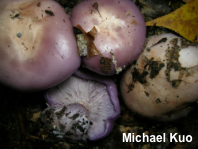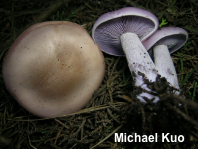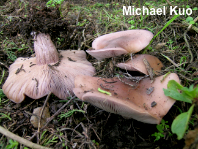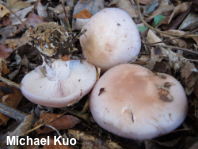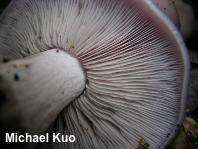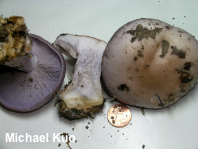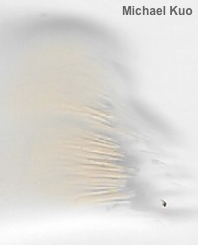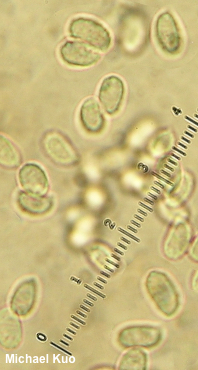| Major Groups > Gilled Mushrooms > Pink-Spored > Clitocyboid Mushrooms > Clitocybe nuda |

|
Clitocybe nuda [Basidiomycota > Agaricales > Tricholomataceae > Clitocybe...] by Michael Kuo Widely distributed across the globe, and sometimes given the common name "blewit," Clitocybe nuda is fairly easily recognized when fresh and young—but older specimens can be confused with many potential look-alikes. The gorgeous shades of purple, lilac, and lavender on the cap, gills, and stem fade quickly; the cap becomes brownish, and the gills and stem fade to buff. However, this color transformation is one of the mushroom's distinguishing features, along with its pale pinkish spore print, its lack of a partial veil, and its tendency to grow in piles of organic debris. Similar species include Clitocybe sordida, which is smaller, hygrophanous, and generally has a bump in the middle of the cap—and Clitocybe personata (also known as Clitocybe saeva), which features a cap that is never purple but a stem that consistently is, creating an attractive contrast. Clitocybe glaucocana, if it is indeed a separate species, is a very pale lilac species (like, nearly whitish) that never features brown. Finally, many species of Cortinarius can look very similar, but feature rusty brown spore prints. Lepista nuda is a synonym—and combinations in Lepista are often used for the various Clitocybe species discussed above. For a discussion of the ongoing taxonomic nightmare surrounding Clitocybe, Lepista, Collybia, and other closely related genera, as well as my justification for not using Lepista, see the page for clitocyboid mushrooms. Description: Ecology: Saprobic; growing alone, scattered, gregariously, or in clusters in organic debris—in woods, grasslands, or in urban settings; late summer and fall (and over winter in warm climates); originally described from France; widespread in Europe and North America; also reported from Asia, South America, and Oceania. The illustrated and described collections are from Illinois and Kentucky. Cap: 3–12 cm across; convex with an inrolled margin when young, becoming broadly convex to nearly flat—or with an uplifted, wavy margin in age; bald; slightly tacky when moist; when fresh usually dull purple, or purplish with brown shades, fading to brownish, tan, or paler—but sometimes brown or buff from the beginning. Gills: Attached to the stem, sometimes by a notch; crowded; short-gills frequent; pale lavender to lilac, fading to buff or pinkish-buff. Stem: 4–6 cm long; 2–2.5 cm thick; equal, or enlarged toward the base; dry; finely fibrillose; pale purple or colored like the gills; becoming pale brownish in age; basal mycelium ranging from white to lilac or purple. Flesh: Thick; soft; purplish to lilac-buff or whitish; not changing when sliced. Odor and Taste: Odor fragrant and sweet; taste not distinctive. Chemical Reactions: KOH negative on cap surface and on flesh. Spore Print: Pinkish. Microscopic Details: Spores 5.5–8 x 3–4 µm; ellipsoid; finely verrucose; inamyloid; hyaline in KOH; cyanophilic. Basidia 22–25 x 4–5 µm; clavate; 4-sterigmate. Cystidia not found. Pileipellis an ixocutis of elements 2–5 µm wide, smooth, hyaline in KOH; clamp connections present. REFERENCES: (J. B. F. Bulliard, 1790) H. E. Bigelow & A. H. Smith, 1969. (Kauffman, 1918; Smith, 1975; Smith, Smith & Weber, 1979; Phillips, 1981; Bigelow, 1982; Weber & Smith, 1985; Arora, 1986; Breitenbach & Kränzlin, 1991; Phillips, 1991/2005; Schalkwijk-Barendsen, 1991; Lincoff, 1992; Metzler & Metzler, 1992; Noordeloos & Kuyper, 1995; Barron, 1999; Roody, 2003; McNeil, 2006; Miller & Miller, 2006; Gregory, 2007; Kuo, 2007; Nonis, 2007; Trudell & Ammirati, 2009; Buczacki et al., 2013; Kuo & Methven, 2014; Desjardin, Wood & Stevens, 2015; Evenson, 2015; Siegel & Schwarz, 2016; Gminder & Böhning, 2017; Woehrel & Light, 2017; Christensen & Gulden, 2018; Elliott & Stephenson, 2018; Sturgeon, 2018; Læssøe & Petersen, 2019; Kibby, 2020; Wood & Dunkelman, 2020; MacKinnon & Luther, 2021; McKnight et al., 2021.) Herb. Kuo 10129601, 10150406, 10261703. This site contains no information about the edibility or toxicity of mushrooms. |
© MushroomExpert.Com |
|
Cite this page as: Kuo, M. (2022, February). Clitocybe nuda. Retrieved from the MushroomExpert.Com Web site: http://www.mushroomexpert.com/clitocybe_nuda.html |
